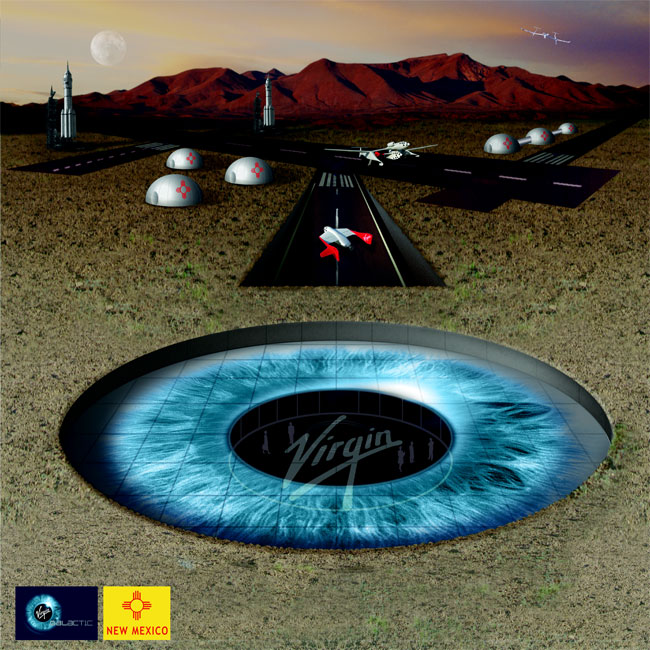New Mexico Spaceport: Getting Down To Business

Creation of a spaceport in New Mexico to handle excursions of commuters to the edge of space is a work in progress. But not only are sky-high dreamers needed. Lots of political propulsion fueled by high-financing is also crucial.
In early December, New Mexico Governor Bill Richardson and Sir Richard Branson, Chairman of Virgin Companies announced a partnership to build the world's first purpose-built spaceport.
Branson's Virgin Galactic will locate its world headquarters and mission control for its personal spaceflight business at the Southwest Regional Spaceport complex. The facility will be built upon a 27-square-mile site in Upham, about 45 miles northeast of Las Cruces and 25 miles southeast of Truth or Consequences.
Construction will begin in 2007 and should be completed by 2009/2010. Virgin Galactic officials estimate some 50,000 customers will fly into space in the first ten years of operation.
Wonders of the world
For Richard Branson, wealthy British entrepreneur and adventurer, he clearly sees spaceliners in his future.
Branson told SPACE.com, after making a personal inspection of the spaceport to be, that the remote sandy landscape is "beautiful, absolutely gorgeous...with lovely mountain ridges around it." The locale is not far from lakes and rivers, "so we can make a real experience for people coming, which is important," he added.
Breaking space news, the latest updates on rocket launches, skywatching events and more!
Virgin Galactic operations and the firm's facilities at the spaceport will be driven by the designs of SpaceShipTwo and the White Knight Two mothership that hauls the passenger-carrying rocket plane to high altitude for release.
Both vehicles are under development by hot shot aerospace designer Burt Rutan and his team at Scaled Composites in Mojave, California under a newly formed group, The Spaceship Company. Last July, Branson and Rutan announced their signing of an agreement to form the new aerospace production company that will build a fleet of commercial suborbital spaceships and launch aircraft.
Unexplored territory
The New Mexico spaceport is to be environmentally friendly in consideration of the local surroundings, featuring an eye looking up into space, Branson said. "As you look down at it from space, seeing this giant eye in the middle of the desert....maybe I'm over exaggerating it...but I think it could be one of the wonders of the world as viewed from above. It'll be pretty spectacular."
Branson said that, as spaceports mature, spaceships jumping point-to-point between them "would be a lovely thing to be able to do...and we'd very much support that as an idea."
The deal struck between Virgin Galactic and New Mexico hastens the day of affordable space trips for more and more of the general public - a lowering of Virgin Galactic's $200,000 seat price of today, Branson advised. "I think that all helps make it possible...in the not too distant future."
Branson admited that the venture "is odd ball in that this is completely unexplored territory," but he noted, running safe public transportation--be it Virgin's flying of airplanes, or its train company--is something they have a track record in doing. "We are used to transporting millions of people...transporting them safely. And we want to keep that impeccable record so," Branson explained. "We know what our priorities are."
Fresh piece of land
"It's a really great site," said Will Whitehorn, president of Virgin Galactic in taking a look at the spot where the New Mexico spaceport is to be born.
New Mexico's backing of the spaceport is important, "because we're investing $150 million in building the spaceship and bringing the spaceships down here," Whitehorn noted during a December 14 press briefing held in Santa Fe, New Mexico. "It would be a bit inconvenient not to have a spaceport when we're finished."
Whitehorn highlighted the essential role that the Mojave Spaceport in California will play, not only where SpaceShipTwo is to be tested but even to handle early suborbital passenger flights.
But by shifting Virgin Galactic operations to the New Mexico spaceport, the volume of flights and other operations can be guaranteed. "There's clear airspace over the site in New Mexico. The weather is better for launching a very big aircraft. We've got the capacity to build an extra-wide runway. This is a very good location to operate from," Whitehorn told SPACE.com.
Also bullish on the emerging personal space travel business and moving forward on the New Mexico spaceport is Alex Tai, Director of Operations at Virgin Galactic. He oversees the design and building of the new SpaceShipTwo now on order, and also plans to pilot the first commercial flight of the spaceliner.
"We want to use the latest technological approaches...the latest thought processes, and the brilliance that's around us with Burt Rutan," Tai observed. "That's what we've got here. A fresh piece of land, a fresh approach and, hopefully, we'll build a whole new industry."
Fundable future
The relationship between Virgin Galactic and New Mexico is "very simple and very clear," said New Mexico Economic Development Secretary Rick Homans, also Chairman of the New Mexico Spaceport Authority. "They've agreed to bring their world headquarters and primary operating base to New Mexico if the state builds a spaceport."
Given that spaceport, Virgin Galactic will lease the facility for a 20-year period, and the terms of the lease will cover the construction and the financing of that facility. The first five years of the lease, payments will be capped at $1 million a year. The lease payments for the other 15 years will be adjusted to pay for the construction and financing of Virgin Galactic facilities.
The other relationship with Virgin will be like a traditional airport, Homans said, with the space travel company paying user fees for specific, direct costs associated with their operations.
"All of this...we're all extremely aware that we are doing something that nobody has done before," Homans told SPACE.com.
New Mexico Governor Bill Richardson announced on December 14 that he will work with the state legislature to secure a three-year commitment for a total of $100 million for the state's share of the funding to build the world's first commercial spaceport to be built in southern New Mexico.
Richardson's funding package will be the keystone of a larger $225 million financial construction package that includes local, state and federal funding to build New Mexico's spaceport in Upham.
Homans said the additional funding is expected to come from a combination of sources, including: Federal earmarks and appropriations over the next three fiscal years; Southern New Mexico cities and counties, by a proposed local option gross receipts tax that will be decided by the voters; and other state sources, including future transportation funding and money that has already been approved by the state legislature for construction of the spaceport.
Building a MArket
Homans said Virgin is a "great launch partner" for the endeavor. However, there remains the task of educating and spurring to greater numbers the space traveling public.
"The lay person thinks this is a rocket going into space...kinda crazy with a lot of risk. They don't understand that the technology being embraced and adopted here eliminates a lot of the risk points that have traditionally been associated with the potential of taking people into space," Homans said.
Virgin is a company that is primarily in the transportation business, and their chief trademark is safety, Homans explained. "They have zero interest in doing anything that would put a blemish on their safety record...because of the impact that it would have on the rest of their brand and the rest of their businesses."
Same goes for New Mexico, Homans pointed out. "We want to have very high safety standards. We intend to create a set of safety criteria that companies need to meet before they will be allowed to launch from the spaceport," he explained.
There are other hurdles still ahead. For one, the spaceport environmental impact statement paperwork must be completed. Also ahead is the Federal Aviation Administration's spaceport licensing process.
"We hope to complete both by the end of 2006," Homans said. "We still seem to be on track to make that happen."
- Virgin Galactic Sets Deal With New Mexico Spaceport
- Gov't Issues Proposed Space Tourism Rules
- Virgin Galactic and the Future of Commercial Spaceflight
- Vote for the Best Cosmic Images of 2005!

Leonard David is an award-winning space journalist who has been reporting on space activities for more than 50 years. Currently writing as Space.com's Space Insider Columnist among his other projects, Leonard has authored numerous books on space exploration, Mars missions and more, with his latest being "Moon Rush: The New Space Race" published in 2019 by National Geographic. He also wrote "Mars: Our Future on the Red Planet" released in 2016 by National Geographic. Leonard has served as a correspondent for SpaceNews, Scientific American and Aerospace America for the AIAA. He has received many awards, including the first Ordway Award for Sustained Excellence in Spaceflight History in 2015 at the AAS Wernher von Braun Memorial Symposium. You can find out Leonard's latest project at his website and on Twitter.
